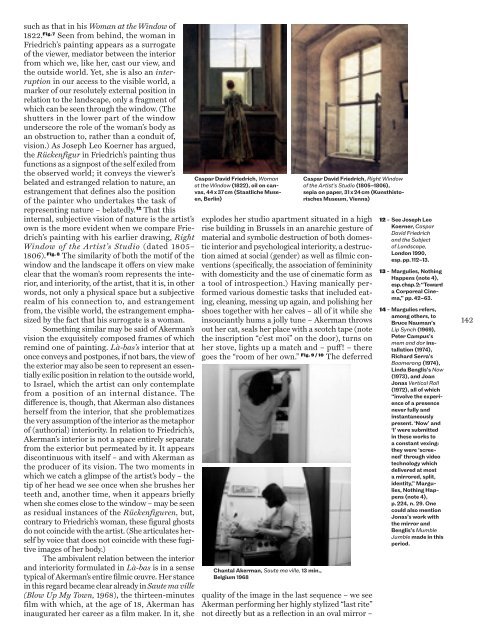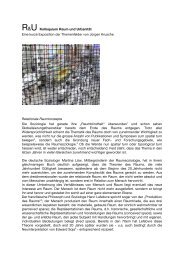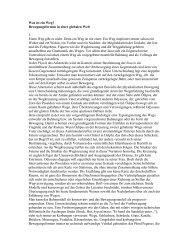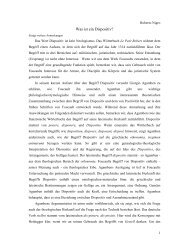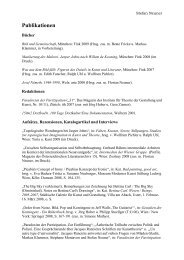Heft - Institut für Theorie ith
Heft - Institut für Theorie ith
Heft - Institut für Theorie ith
Erfolgreiche ePaper selbst erstellen
Machen Sie aus Ihren PDF Publikationen ein blätterbares Flipbook mit unserer einzigartigen Google optimierten e-Paper Software.
such as that in his Woman at the Window of<br />
1822. Fig.7 Seen from behind, the woman in<br />
Friedrich’s painting appears as a surrogate<br />
of the viewer, mediator between the interior<br />
from which we, like her, cast our view, and<br />
the outside world. Yet, she is also an interruption<br />
in our access to the visible world, a<br />
marker of our resolutely external position in<br />
relation to the landscape, only a fragment of<br />
which can be seen through the window. (The<br />
shutters in the lower part of the window<br />
underscore the role of the woman’s body as<br />
an obstruction to, rather than a conduit of,<br />
vision.) As Joseph Leo Koerner has argued,<br />
the Rückenfigur in Friedrich’s painting thus<br />
functions as a signpost of the self exiled from<br />
the observed world; it conveys the viewer’s<br />
belated and estranged relation to nature, an<br />
estrangement that defines also the position<br />
of the painter who undertakes the task of<br />
representing nature – belatedly. 12 That this<br />
internal, subjective vision of nature is the artist’s<br />
own is the more evident when we compare Friedrich’s<br />
painting w<strong>ith</strong> his earlier drawing, Right<br />
Window of the Artist’s Studio (dated 1805–<br />
1806). Fig. 8 The similarity of both the motif of the<br />
window and the landscape it o≠ers on view make<br />
clear that the woman’s room represents the interior,<br />
and interiority, of the artist, that it is, in other<br />
words, not only a physical space but a subjective<br />
realm of his connection to, and estrangement<br />
from, the visible world, the estrangement emphasized<br />
by the fact that his surrogate is a woman.<br />
Something similar may be said of Akerman’s<br />
vision the exquisitely composed frames of which<br />
remind one of painting. Là-bas’s interior that at<br />
once conveys and postpones, if not bars, the view of<br />
the exterior may also be seen to represent an essentially<br />
exilic position in relation to the outside world,<br />
to Israel, which the artist can only contemplate<br />
from a position of an internal distance. The<br />
di≠erence is, though, that Akerman also distances<br />
herself from the interior, that she problematizes<br />
the very assumption of the interior as the metaphor<br />
of (authorial) interiority. In relation to Friedrich’s,<br />
Akerman’s interior is not a space entirely separate<br />
from the exterior but permeated by it. It appears<br />
discontinuous w<strong>ith</strong> itself – and w<strong>ith</strong> Akerman as<br />
the producer of its vision. The two moments in<br />
which we catch a glimpse of the artist’s body – the<br />
tip of her head we see once when she brushes her<br />
teeth and, another time, when it appears briefly<br />
when she comes close to the window – may be seen<br />
as residual instances of the Rückenfiguren, but,<br />
contrary to Friedrich’s woman, these figural ghosts<br />
do not coincide w<strong>ith</strong> the artist. (She articulates herself<br />
by voice that does not coincide w<strong>ith</strong> these fugitive<br />
images of her body.)<br />
The ambivalent relation between the interior<br />
and interiority formulated in Là-bas is in a sense<br />
typical of Akerman’s entire filmic œuvre. Her stance<br />
in this regard became clear already in Saute ma ville<br />
(Blow Up My Town, 1968), the thirteen-minutes<br />
film w<strong>ith</strong> which, at the age of 18, Akerman has<br />
inaugurated her career as a film maker. In it, she<br />
Caspar David Friedrich, Woman<br />
at the Window (1822), oil on canvas,<br />
44 x 37 cm (Staatliche Museen,<br />
Berlin)<br />
explodes her studio apartment situated in a high<br />
rise building in Brussels in an anarchic gesture of<br />
material and symbolic destruction of both domestic<br />
interior and psychological interiority, a destruction<br />
aimed at social (gender) as well as filmic conventions<br />
(specifically, the association of femininity<br />
w<strong>ith</strong> domesticity and the use of cinematic form as<br />
a tool of introspection.) Having manically performed<br />
various domestic tasks that included eating,<br />
cleaning, messing up again, and polishing her<br />
shoes together w<strong>ith</strong> her calves – all of it while she<br />
insouciantly hums a jolly tune – Akerman throws<br />
out her cat, seals her place w<strong>ith</strong> a scotch tape (note<br />
the inscription “c’est moi” on the door), turns on<br />
her stove, lights up a match and – pu≠! – there<br />
goes the “room of her own.” Fig. 9 / 10 The deferred<br />
Chantal Akerman, Saute ma ville, 13 min.,<br />
Belgium 1968<br />
Caspar David Friedrich, Right Window<br />
of the Artist’s Studio (1805–1806),<br />
sepia on paper, 31 x 24 cm (Kunsthistorisches<br />
Museum, Vienna)<br />
quality of the image in the last sequence – we see<br />
Akerman performing her highly stylized “last rite”<br />
not directly but as a reflection in an oval mirror –<br />
12 - See Joseph Leo<br />
Koerner, Caspar<br />
David Friedrich<br />
and the Subject<br />
of Landscape,<br />
London 1990,<br />
esp. pp. 112–13.<br />
13 - Margulies, Nothing<br />
Happens (note 4),<br />
esp. chap. 2: “Toward<br />
a Corporeal Cinema,”<br />
pp. 42–63.<br />
14 - Margulies refers,<br />
among others, to<br />
Bruce Nauman’s<br />
Lip Synch (1969),<br />
Peter Campus’s<br />
mem and dor installation<br />
(1974),<br />
Richard Serra’s<br />
Boomerang (1974),<br />
Linda Benglis’s Now<br />
(1973), and Joan<br />
Jonas Vertical Roll<br />
(1972), all of which<br />
“involve the experience<br />
of a presence<br />
never fully and<br />
instantaneously<br />
present. ‘Now’ and<br />
‘I’ were submitted<br />
in these works to<br />
a constant vexing:<br />
they were ‘screened’<br />
through video<br />
technology which<br />
delivered at most<br />
a mirrored, split,<br />
identity,” Margulies,<br />
Nothing Happens<br />
(note 4),<br />
p. 224, n. 29. One<br />
could also mention<br />
Jonas’s work w<strong>ith</strong><br />
the mirror and<br />
Benglis’s Mumble<br />
Jumble made in this<br />
period.<br />
142


